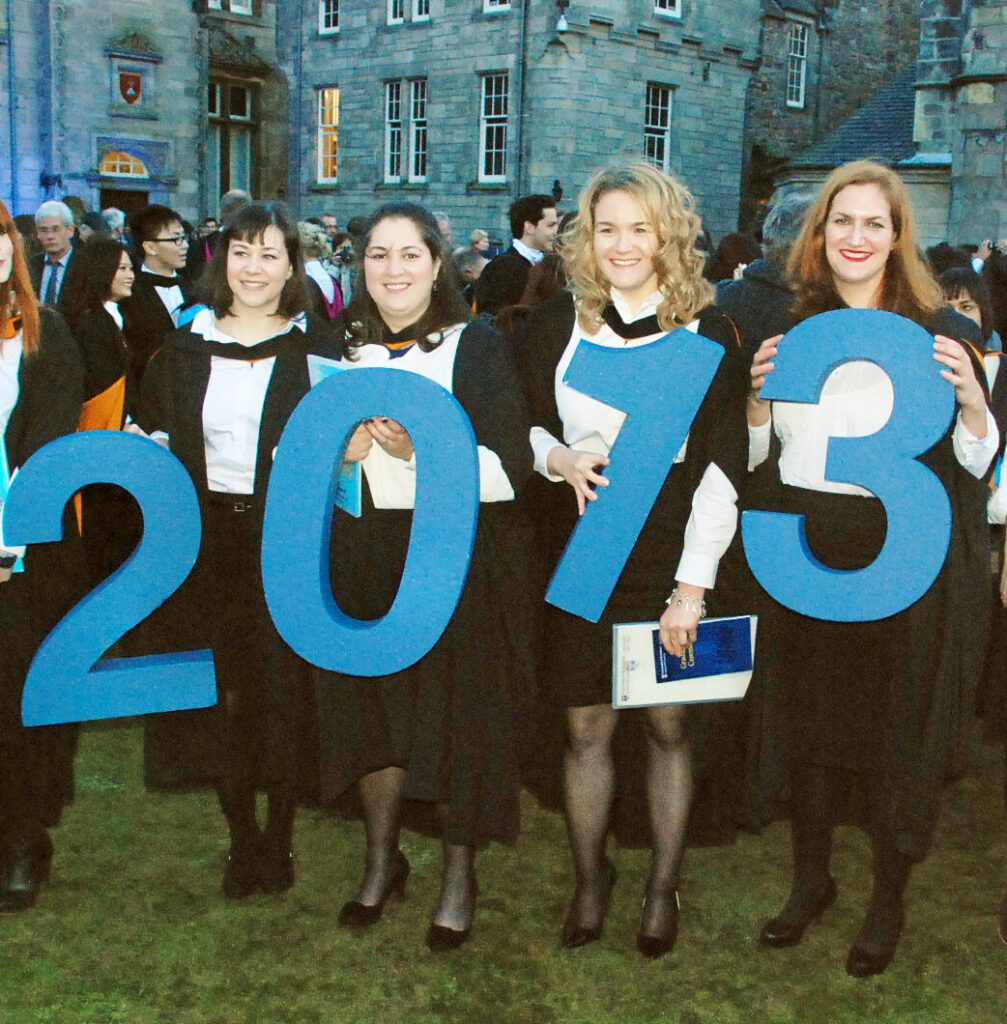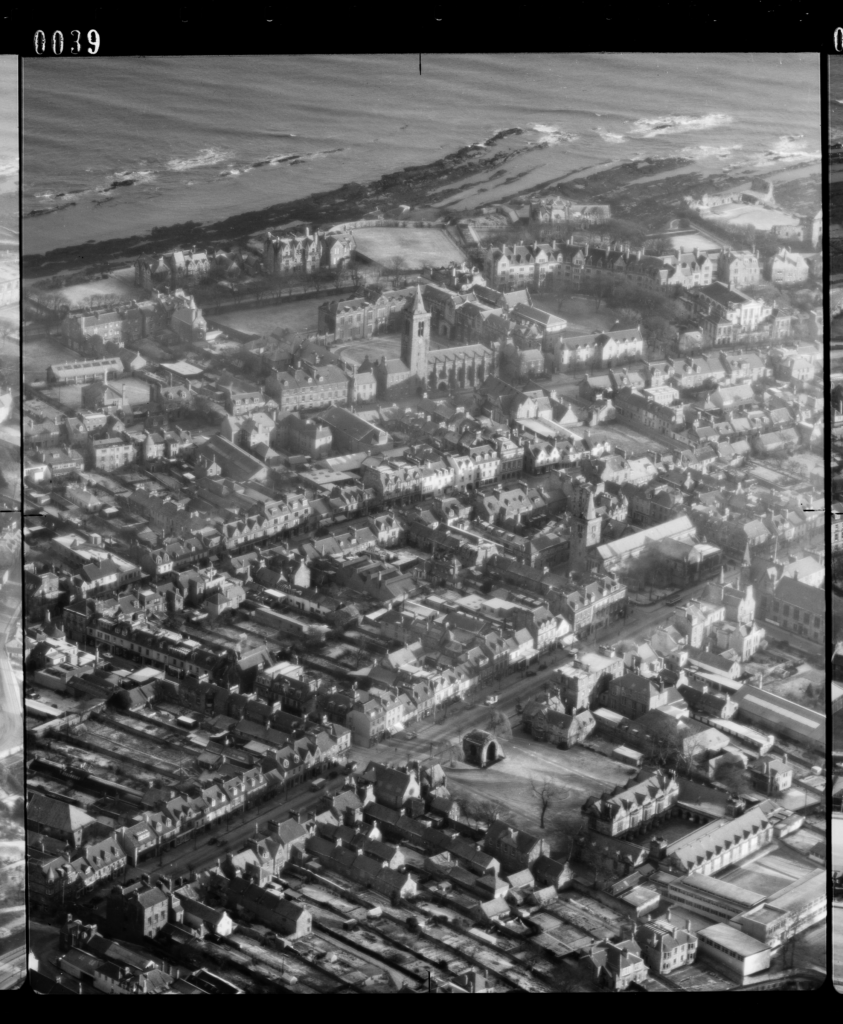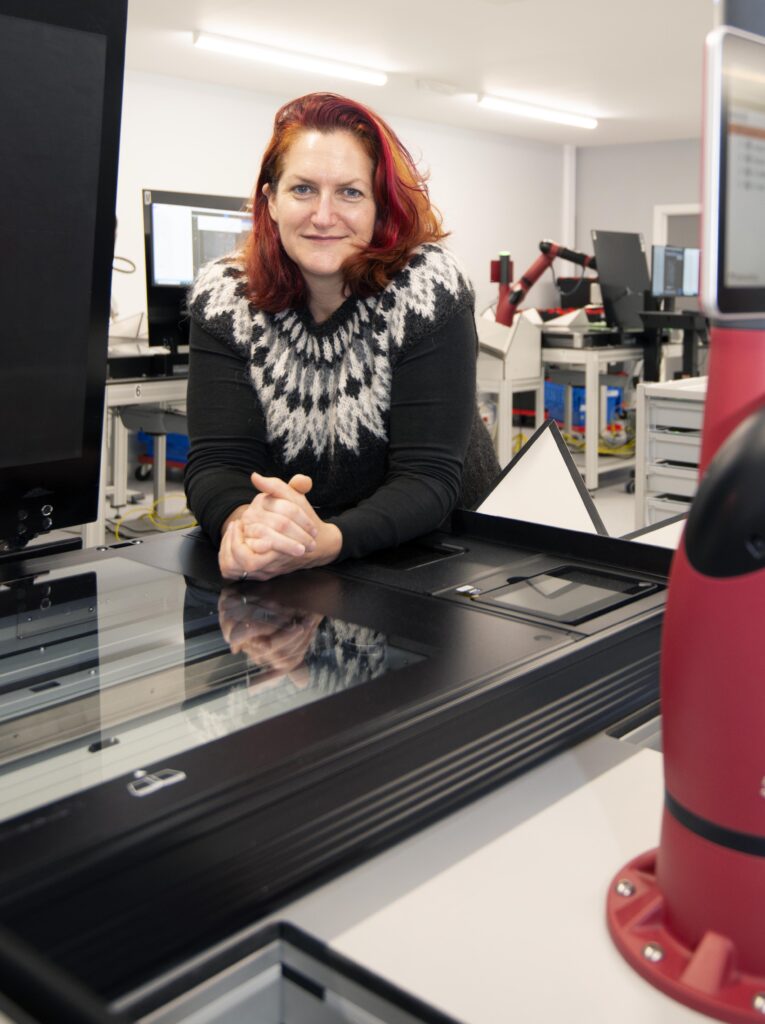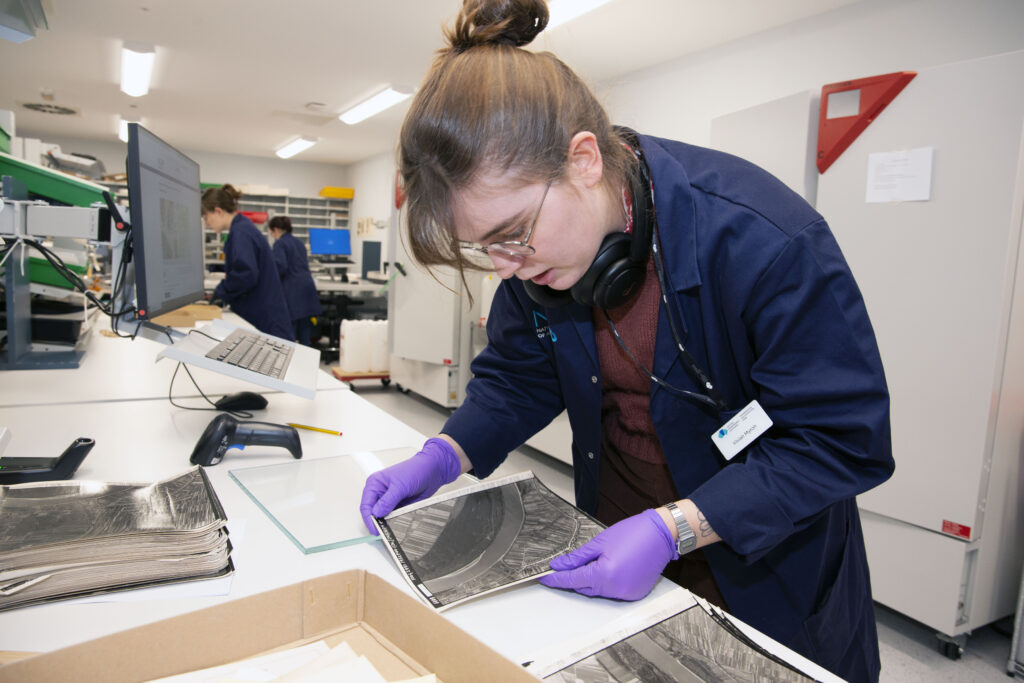From MLitt to NCAP
Sheila Masson, MLitt 2013, describes how a postgraduate degree from St Andrews ultimately led to her current role as Photographic Preservation Manager of the National Collection of Aerial Photography (NCAP) for Historic Environment Scotland, with a team largely comprising St Andrews alumni!
Coming to St Andrews
After living in the USA for twenty years, I moved back to the UK in 2009 – partly to be closer to my family, but also for more practical reasons, including the NHS, more generous annual leave and more affordable further education. I chose to live in Edinburgh (my family’s home city) rather than London (where I was born and brought up) because I had always felt a strong connection to Scotland that had never been fulfilled. I had been considering a postgraduate degree for many years, but my options in the USA were eye-wateringly expensive with no guarantee of increasing my employment prospects. In fact, by the time I was accepted at St Andrews for the MLitt in History of Photography it had been 17 years since my BA (Hons) degree in illustration and photography at what was the then Kent Institute of Art and Design in Maidstone (now The University for the Creative Arts).
I have worked in various roles within photography during my career: I was a picture editor on several large historic photographic collections in New York City, a photo assistant to a major photographer in Los Angeles, a picture researcher/editor for several publishing companies in San Francisco and, most significantly, I worked as a freelance and staff photojournalist for newspapers in Los Angeles and the San Francisco Bay Area. However due to the advent of online newspapers, the subsequent reduction in both revenue and staff in the news industry, and then seeing fellow photojournalists higher up the career ladder lose their jobs, I realised that my chosen career was too precarious and that I should investigate moving in a different direction.
After relocating to Edinburgh, I began to look at job listings and I quickly realised the historic photographic collection posts that interested me most required a postgraduate degree. I researched photography masters options across the UK and discovered the MLitt History of Photography course at St Andrews. The course description absolutely sang to me: I didn’t want to have to choose which modules to take – I wanted to do all of them. The location also helped: my maternal grandparents lived in Fife in their later years and in fact my grandfather, the noted plastic surgeon AB Wallace, completed his PhD at St Andrews after he retired from clinical practice. Growing up, my family and I visited St Andrews from North London every year and I have many happy childhood memories of playing in the sand dunes of the West Sands, swimming in the sea and running along the stone pier with my sister and cousins.
Memories
Coming to St Andrews as a mature student – following a studio-based undergraduate degree and almost two decades of industry experience – I vividly remember the steep learning curve and high academic expectations I experienced, as well as the seminars I attended with my significantly younger cohort (I’m still in touch with many of them despite being old enough to be their mother!).
Other memories include long days reading, researching and writing in the postgraduate garret study rooms in the Art History department, with views looking out over the rooftops of North Street and beyond. I also remember the early mornings I spent in the University Library, catching up on reading and looking out towards The Scores and St Andrews Bay.
I received exemplary support and guidance from Prof Natalie Adamson and Dr Luke Gartlan, whose rigorous seminars and weekly short papers whipped me into shape. I also left with an absolute love and appreciation of the architecture and history of St Andrews, particularly after living in the United States for 20 years; the stone buildings and narrow streets have never lost their magic.

From St Andrews to NCAP
While at St Andrews I continued to work part-time running a picture agency in Edinburgh, and my studies also led me to work one day a week as a volunteer photo historian at the National Museum of Scotland (NMS) on Chambers Street in Edinburgh. I helped to research and document items for the ‘Photography: A Victorian Sensation’ exhibition, and I was later hired as a teaching assistant on an associated partnership MOOC (Massive Open Online Course) between NMS and the University of Edinburgh. I also became a committee member of the Scottish Society for the History of Photography, and the community of photo historians that I met throughout this process has provided me with invaluable mentorship and peers.
Ten years on from St Andrews I now work at the National Collection of Aerial Photography (part of Historic Environment Scotland) in Edinburgh, managing special projects in which we preserve and then digitise huge historic photographic collections with a team of six humans and seven robots.

We have just completed our first major project: the automated digitisation of almost 1.7 million aerial survey photographs of 55 Commonwealth countries. These were taken between 1946 and the 1990s by the Directorate of Overseas Surveys (DOS), a British Colonial Office unit, to create Ordnance Survey-type maps of these areas.
The DOS Project has been a major partnership grant-funded by the Bank of Sweden Tercentenary Foundation between Historic Environment Scotland, the Department of Economics at Stockholm University and the Department of Agricultural & Resource Economics at the University of California in Berkeley.
We have pioneered the use of cobots (collaborative robots) to digitise our substantial collections, working with engineers to create bespoke robotic scanning workstations. In the right conditions the cobots can work 24/7, albeit with monitoring by our human staff.

After completing the scans at NCAP, we send the data to our international partners, who are digitally stitching together the images to create merged, georeferenced mosaics that resemble modern satellite imagery, albeit in black and white. By making the photography accessible in digital form, the DOS Project will transform the availability of historical data that records global environmental change over the past century. The data will increase understanding of the causes and consequences of long-run environmental change, including biodiversity loss, deforestation and climate change. And as such, the merged/georeferenced mosaics created by our international partners will be become available for academic research purposes.
An abundance of St Andrews alumni …
Interestingly for an organisation of less than 30 employees, NCAP now has a substantial number of St Andrews graduates. On my team of seven we have a total of four alumni, and all from the History of Art department. This includes me (MLitt History of Photography, 2013), Joshua Al Najar (MLitt History of Art, 2021), Mairi Westlake (MLitt Museum & Gallery Studies, 2022) and Vivian Myron (MLitt History of Photography, 2023). In June 2022 we were delighted to welcome Rachel Nordstrom, Honorary Research Fellow and former Photographic Collections Manager at St Andrews, now the Operations Manager at NCAP, whom I first met 10 years ago during her first week at the University.

The reasons for our abundance of St Andrews alumni might be the desire of so many students to stay in Scotland and the attraction of working for Historic Environment Scotland. Furthermore, along with some of the other ancient Scottish Universities, it’s St Andrews’ heritage-focused Masters programmes in the School of Art History that are driving students to us, and we are delighted to see so many dedicated, engaged and knowledgeable applicants from these courses.
The importance of work and volunteering experience
To any alumni or students considering a career in heritage, my advice is that during your holidays you should volunteer or get paid intern experience at your hometown museum/community archive/local library special collection. It doesn’t have to be full time or at a major or well-known institution – in fact you’re more likely to get the desired experience if it ISN’T a big name. Even just a few hours a week for a few months is worth it, if having the time to volunteer alongside paid work or family commitments is difficult.
During term time, if there’s nothing appropriate or available in St Andrews, look at Dundee or some of the towns across Fife that might have interesting collections in their archives that they are in desperate need of researching or digitising. It’s also a great way to discover what subject matter or types of organisations really interest you, and you can fall down some fascinating rabbit holes (and perhaps discover your dissertation subject!).
Further information
Find out about opportunities in Historic Environment Scotland or contact Sheila Masson for more information.
What a fascinating job, and great advice to younger people who want to enter art careers in some way. I was at St. Andrews when the Department of Art History first opened taking an introductory course with Prof. Speers. I basically have a minor in art history. I came from the US, entering St. Andrews in 1967, and graduating in 1970. My daughter graduated from Cambridge College of Art and Design nearly 20 years ago, and now I wonder if she would have been better off at St. Andrews. Her first desire was to be a photographer, and she did a 6 month internship in NYC for a photographers' agent, and she also worked at National Geographic for a couple of years researching photos for copyright attribution and to build a complete catalog. She eventually turned her skills to Graphic Design and now lives in Spain working permanently for a US company doing a lot of web design. Art has so many facets and I'm glad your article bring out the different possibilities. Your project sounds fascinating! What an opportunity.